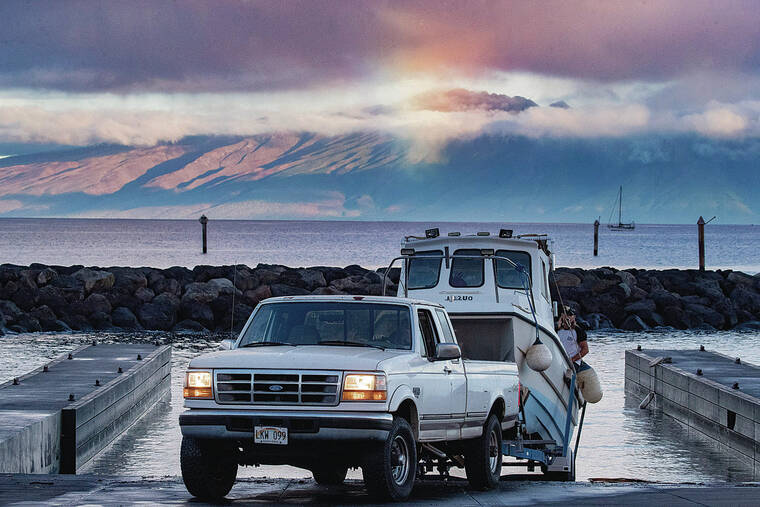Maui’s west-side commercial boating operators are getting some relief from the business impacts of the Maui wildfires with the state’s decision to lift temporary restrictions at Mala Wharf and its announcement that the rebuilding of a
fueling system is underway at
Lahaina Small Boat Harbor.
The state Department of Health also declared Thursday that the coastal waters around Lahaina are safe for ocean recreation, which is likely to validate use for offshore recreational and commercial users as well as recreational and commercial boats.
DOH said it came to its conclusion after reviewing test results from multiple monitoring activities including state agencies and community partners, among them the University of Hawaii, the state Department of Land and Natural Resources and the Surfrider
Foundation.
Deputy Director for Environmental Health Kathleen Ho said in a statement, “These results provide the community with reassurance that the coastal waters around Lahaina are safe for ocean recreation with no significant human health impacts as a result of the wildfires. We continue to advise residents to heed brown water advisories, as bacteriological quality remains a concern at all times in brown water conditions. DOH appreciates the collaboration and partnership of our community partners and DLNR in monitoring environmental quality in Lahaina.”
DOH said it will continue to monitor coastal environmental quality in Lahaina along with its partners, and reminded the public that access at certain coastal zones in Lahaina still are not open for ocean recreation.
Lahaina Small Boat Harbor sustained $30 million worth of damage in the Aug. 8 Maui wildfires, and its destruction continues to affect recreational users as well as Maui’s activities and attractions market, which is struggling to recover.
The U.S. Coast Guard completed the salvage of all Lahaina Harbor vessels in December, and the state has begun addressing its checklist to safely reopen Lahaina Harbor, which could require dredging.
The fuel system vendor for Lahaina Small Boat Harbor, Pacific Fuels, is rebuilding the fire-damaged, above-ground portion of the fueling system at no cost to the state.
DLNR said the fueling
system restoration, which
is targeted for completion May 18, at popular Lahaina Harbor is the first of many projects to fully restore the harbor to full operations.
Finn McCall, a DLNR Division of Boating and Ocean Recreation engineer, said in a statement, “Probably until it’s fully restored, you know, we’re estimating maybe about three years.”
Heidi Speedie, operations manager of Kolea Charters, which had operated Reefdancer, a semi-sub destroyed in Lahaina Harbor, said the DOH ruling is important for members of the West Maui commercial boating fleet.
She said more convenient access to fuel also is important, especially for the operators, whose boats are too large to fill up at gas stations, and have had to take fuel to their boats via skiffs.
“It will help the boats that already exist in Kaanapali and Mala, but it can’t help
a Lahaina Harbor boat like mine,” she said. “You can fill up your boat, but you’ll never use your fuel if you can’t put a passenger on the boat. It’s only good for people that are able to do business.”
Speedie said Mala Wharf commercial boaters also will get some grace Saturday when DLNR allows them to return to Mala Wharf seven days a week, instead of banning holiday and weekend use.
“It’s just too bad that they couldn’t have reopened in time for whale watching
season, which starts in mid-
December and is finished before mid-May,” Speedie said. “Whale watching season for commercial boaters is like the end-of-the-year holiday season is for retailers. We had lots of bad weather this year, so between the holiday and weekend restrictions, operators were seeing weekly cuts to business ranging from 25% to 50%.”
DLNR said it began restricting access for many
reasons to commercial boats on weekends when Mala Wharf reopened in October. Those reasons included “the absence of a Division of Boating and Ocean Recreation (DOBOR) office in West Maui; the lack of operational restrooms; potential health risks from exposure to contaminants in the ocean, and the unsafe conditions of nearshore waters due to
debris from the August 2023 wildfires. Concerned Lahaina residents also indicated
they wanted commercial
operations restricted.”
Kekai Keahi, whose grandmother’s house is about 150 to 200 yards from the ramp at Mala Wharf, called DLNR/DOBOR’s reversal “devastating.”
He said the community
already had made clear
to DLNR/DOBOR that
commercial use at Mala Wharf should not be allowed before undergoing a Ka Pa‘akai analysis, which
provides a framework for
assessing impacts to Native Hawaiian constitutionally protected rights. He contends that such an analysis would not uphold commercial use.
“My dad (Moke Keahi) and people of his generation was the ones that led that fight to build (Mala Wharf). It wasn’t the state; it was the people here who was pushed out of Lahaina harbor who couldn’t even go fishing anymore. It was their ocean, their fight.
“It’s just a small little ramp, not even a harbor. For them to fight so hard just to give us a place to go so we can subsist, to be run over by tourism again is history repeating itself. If my generation doesn’t do something about it now, then my boy’s generation is going to suffer real bad.”
It’s unclear whether the full restoration of Mala Wharf operating hours will stick.
DLNR said an attorney for two commercial operators had requested that the Mala Wharf restriction be lifted, and in a response letter DLNR Chair Dawn Chang advised, “Please be aware that we are currently working on amending DOBOR administrative rules to implement commercial activity prohibitions on weekends and holidays at Mala Wharf and other boating facilities, similar to the Kaneohe Bay restrictions on Oahu.”
Kekai Keahi said, “When I see it I’ll believe it.”






